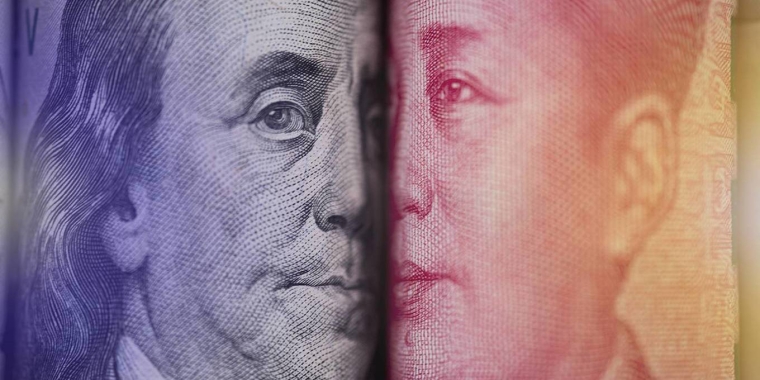
Dealmakers always know when to cut their losses. And so it is with the self-proclaimed greatest dealmaker of them all: US President Donald Trump. Having promised a Grand Deal with China, the 13th round of bilateral trade negotiations ended on October 11 with barely a whimper, yielding a watered-down partial agreement: the “phase one” accord.
This wasn’t supposed to happen. The Trump administration’s three-pronged negotiating strategy has long featured a major reduction in the bilateral trade deficit, a conflict-resolution framework to address problems ranging from alleged intellectual-property theft and forced technology transfer to services reforms and so-called non-tariff barriers, along with a tough enforcement mechanism. According to one of the lead US negotiators, Treasury Secretary Steven Mnuchin, the Grand Deal was about 90% done in June, before it all unraveled in a contentious blame game and a further escalation of tit-for-tat tariffs.
But hope springs eternal. As both economies started to show visible signs of distress, there was new optimism that reason would finally prevail, even in the face of an escalating weaponization of policy by the United States: threatened capital controls, rumored delisting of Chinese companies whose shares trade on American stock exchanges, new visa restrictions, a sharp expansion of blacklisted Chinese firms on the dreaded Entity List, and talk of congressional passage of the Hong Kong Human Rights and Democracy Act of 2019. Financial markets looked the other way and soared in anticipation in the days leading up to the October 11 announcement.
And yet the phase one deal announced with great fanfare is a huge disappointment. For starters, there is no codified agreement or clarity on enforcement. There is only a vague promise to clarify in the coming weeks Chinese intentions to purchase about $40-50 billion worth of US agricultural products, a nod in the direction of a relatively meaningless agreement on currency manipulation, and some hints of initiatives on IP protection and financial-sector liberalization. And for that, the Chinese get a major concession: a second reprieve on a new round of tariffs on exports to the US worth some $250 billion that was initially supposed to take effect on October 1.
Far from a breakthrough, these loose commitments, like comparable earlier promises, offer little of substance. For years, China has long embraced the “fat-wallet” approach when it comes to defusing trade tensions with the US. In the past, that meant boosting imports of American aircraft; today, it means buying more soybeans. Of course, it has an even longer shopping list of US-made products, especially those tied to telecommunications equipment maker Huawei’s technology supply chain.
But China’s open wallet won’t solve America’s far deeper economic problems. The $879 billion US merchandise trade deficit in 2018 (running at $919 billion in the second quarter of 2019) reflects trade imbalances with 102 countries. This is a multilateral problem, not the China-centric bilateral problem that politicians insist must be addressed in order to assuage all that ails American manufacturers and workers. Yet without resolving the macroeconomic imbalances that underpin this multilateral trade deficit – namely, a chronic shortfall of domestic saving – all a China fix could accomplish would be a diversion of trade to higher-cost foreign producers, which would be the functional equivalent of a tax hike on US consumers.
Promises of a currency agreement are equally suspicious. This is an easy, but unnecessary, add-on to any deal. While the renminbi’s exchange rate against the US dollar has fallen by 11% since the trade war commenced in March 2018, it is up 46% in inflation-adjusted terms against a broad constellation of China’s trading partners since the end of 2004. Like trade, currencies must be assessed from a multilateral perspective to judge whether a country is manipulating its exchange rate to gain an unfair competitive advantage.
That assessment makes it quite clear that China does not meet the widely accepted criteria for currency manipulation. Its once-outsize current-account surplus has all but disappeared, and there is no evidence of any overt official intervention in foreign-exchange markets. In August, the International Monetary Fund reaffirmed that very conclusion in its so-called Article IV review of China. Although the US Treasury recently deemed China guilty of currency manipulation, this verdict was at odds with the Treasury’s own criteria, and Mnuchin is now hinting that it may be reversed. Far from essential, a new currency agreement is nothing more than a feeble grab for political bragging rights.
The real problem with the phase one accord is the basic structure of the deal into which it presumably fits. From trade to currency, the approach is the same – prescribing bilateral remedies for multilateral problems. That won’t work. Multilateral problems require solutions aimed at the macroeconomic imbalances on which they rest. That could mean a reciprocal market-opening framework like a bilateral investment treaty or a rebalancing of saving disparities between the two countries that occupy the extremes on the saving spectrum.
The saving issue is especially critical for the US. America’s net domestic saving rate of just 2.2% of national income in the second quarter of 2019 is far short of the 6.3% average in the final three decades of the twentieth century. Boosting saving – precisely the opposite of what the US is doing in light of the ominous trajectory of its budget deficit – would be the most effective means by far to reduce America’s multilateral trade imbalance with China and 101 other countries. Doing so would also take the misdirected focus off a bilateral assessment of the dollar in a multilateral world.
A macro perspective is always tough for politicians. That is especially true today in the US, because it doesn’t fit neatly with xenophobic bilateral fixations, like China bashing. With new signs of Chinese resistance now surfacing, the phase one accord may never see the light of day. But if it does, it will hurt more than it helps in addressing one of the world’s toughest current economic problems.
Stephen S. Roach, a faculty member at Yale University and former Chairman of Morgan Stanley Asia, is the author of Unbalanced: The Codependency of America and China. Copyright: Project Syndicate, 2019, published here with permission.
4 Comments
Steven Roach conforms to the 25 year long Group Think that got us to where we are today with China. His comment "A macro perspective is always tough for politicians. That is especially true today in the US, because it doesn’t fit neatly with xenophobic bilateral fixations, like China bashing." couldn't be more discordant with another favorite commentator found regularly on this website-John Mauldin. His opinion is that after 20 years of group think "all will be well in the end" John Mauldin this week has grown so alarmed his article is entitled "China's Disturbing Vision" https://www.mauldineconomics.com/frontlinethoughts
You be ignorant to not recognise what US interests have been doing to the countries with resources they continue to exploit, and the bias mauldin has towards China.
The US government hardly represents their people, and largely controlled by Oil, Pharmacautiel, Banking & Defence interests; and has been for a century or more. Ever wondered why they dont have a better public transport system? Its suits vested interests not to have one.
The greed of the few in charge created complacency, and strangled their locals with high house prices and low paid jobs. When you globalise markets, jobs go to those that cost the least to employ.
A solution could be to decentralise, and legalise that no business can have more than a 5% market share and can only be owned locally; but a cant see the establishment allowing this.
Your right about the vested interests control-that's why in 23 States the vote was over 50% for Trump, in 6 States he gained a plurality, and then where all the corruption lies in Washing D.C. he gained only 4% of the popular vote. For decades the political establishment who carefully followed the money interests pathway and as a result has prospered in retirement (eg Biden being taken care of in China & Ukraine). The controlling interests provide the golden parachutes when they leave office and take well care of them for following their "think tanks" lobbying. Trump may be a bastard but it was his money on the line, and not rewards that came his way for voting the party line.
Regards Mauldin if you read the article you could see how wrong you are. He was biased for nearly 20 years for the globalist approach which rewarded China as well as US Fortune 500 transplanted factories but has now been awakened and alarmed to find China will never transition into an acceptable nation and woe be it to the nations that don't understand that fact.
As regard to the greed of the few in charge who strange the locals and replace those workers with Globalized workers who are least expensive--well that too can be turned around in a democracy. New Zealand grew from WWII to 1984-that's 40 years on the back of one central and very egalitarian premise which was "what can be manufactured in NZ must be manufactured in New Zealand". During that period the Regions, Wellington, Christchurch and South Auckland all had factories producing everything from pajamas to steros, and car assembly. If the consumer wanted classier products they were available only under a controlled licensing regime which limited the annual export earned dollars that were sent to other countries to buy either the "classier" goods, or the goods that could not be made locally-airplanes, tennis rackets, and even waterbed heaters.
Tariffs enabled the working class to have jobs and affordable houses. The upper class was used to paying for more for their "classier" products. Rogernomics changed all that. Now 35 years on the working class people in democracies all over the world are having a rethink on globalism and tariff free goods imports. The good news is that even the Financial class like John Mauldin are waking to a new dawn and realizing this will never work the way the world has been constructed these last 35 years.
"A macro perspective is always tough for politicians. That is especially true today in the US, because it doesn’t fit neatly with xenophobic bilateral fixations, like China bashing."
Try reading Deceiving the Sky: Inside Communist China's Drive for Global Supremacy by Bill Gertz.
We should be worried about China.
Trump has every right to call them out.

We welcome your comments below. If you are not already registered, please register to comment.
Remember we welcome robust, respectful and insightful debate. We don't welcome abusive or defamatory comments and will de-register those repeatedly making such comments. Our current comment policy is here.